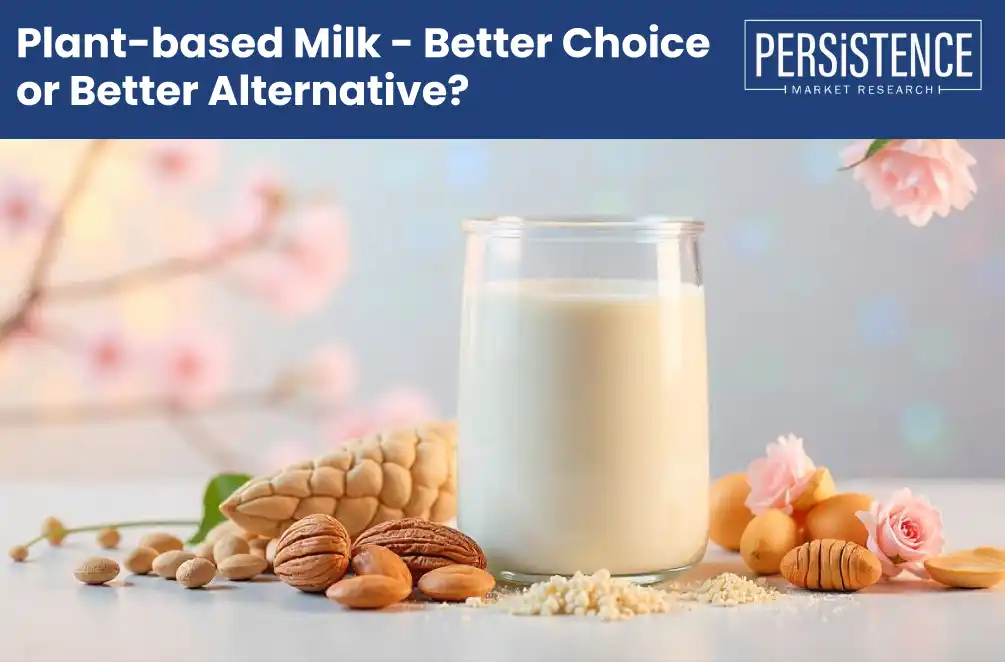- Blog
- Plant Based Milk Guide
Plant-based Milk - Better Choice or Better Alternative?
Published On : 23 Jun 2025
What Is Plant-based Milk?
Plant milk is a sophisticated beverage crafted by extracting proteins, fats, and sugars from plants and blending them into a drinkable form. Unlike traditional animal milks sourced from cows, goats, or sheep, plant-based milks made from almonds, cashews, coconuts, hazelnuts, peanuts, sesame, soy, tiger nuts, oats, rice, hemp, and walnuts are rapidly gaining market share.
 According to the Plant-Based Food Association (PBFA) 2023 State of the Marketplace Report, U.S. retail dollar sales for plant-based milk hit US$ 2.9 billion. Despite a 7.5% decline in unit sales, 44.1% of households purchased plant-based milk, with an impressive 78.5% of those shoppers making repeat purchases. Popular global brands include Oatly (oat-based), Ripple (pea protein-based), Almond Breeze (almond), Silk (soy, almond, and coconut varieties), Califia Farms (almond and oat), Alpro (soy, almond, oat), Blue Diamond (almond), Pacific Foods (variety of organic nut and grain-based milks).
According to the Plant-Based Food Association (PBFA) 2023 State of the Marketplace Report, U.S. retail dollar sales for plant-based milk hit US$ 2.9 billion. Despite a 7.5% decline in unit sales, 44.1% of households purchased plant-based milk, with an impressive 78.5% of those shoppers making repeat purchases. Popular global brands include Oatly (oat-based), Ripple (pea protein-based), Almond Breeze (almond), Silk (soy, almond, and coconut varieties), Califia Farms (almond and oat), Alpro (soy, almond, oat), Blue Diamond (almond), Pacific Foods (variety of organic nut and grain-based milks).
In India’s evolving dietary scene, the plant-based milk market is carving a niche. Soy milk is the most popular form among consumers, followed by almond and oat milk, signaling a shift toward health-conscious and environmentally aware consumption. Epigamia, Sofit, So Good, Oat Mylk, Raw Pressery, and Urban Platter (popular in India with a range spanning soy, almond, oat, and coconut) each have carved a niche by emphasizing unique nutritional strengths, plant sources, or sustainability stories.
Varieties, Production & Nutrition: The Essentials of Plant-based Milk
Many consumers choose plant-based milk due to lactose intolerance, evolving dietary habits, and health trends. They are also motivated by concerns of animal welfare, the environment, and sustainability. Nutritionally, plant milks are rich in antioxidants and healthy fats but often are low in protein and bioavailable vitamins, and may contain added sugars and additives to improve taste. Blending different plant bases, fermentation, and nutrient recovery from by-products are strategies to tackle this issue. Environmentally, these milks boast a lower water footprint and a reduced climate impact compared to dairy, though research continues on their effects on acidification and eutrophication.
Globally, plant-based milk appeals especially to those with cow’s milk allergies, lactose intolerance, or cholesterol concerns. Despite lower protein and some added sugars, compounds such as phenolics, unsaturated fats, antioxidants, phytosterols, and isoflavones deliver solid health benefits.
In India, plant-based milk is no longer just a curiosity; it is a booming niche market driven by savvy consumers highly aware of health, nutrition, and ethics. Many still consume both animal and plant milks, largely due to the wider availability, affordability, and versatility of dairy, especially in beloved staples such as chai and coffee. Improving distribution, pricing, and compatibility with Indian hot beverages will help capture a larger chunk of the market.
Market Trends & Sales Data of Plant-based Milk: Growth on the Rise
According to the Good Food Institute's 2023 analysis, 37% of German households, over one-third of U.K. households, and 40% of Spanish households have purchased plant-based milk at least once. These figures highlight the growing adoption of plant-based alternatives in the European households. Plant-based milk sales grew 7.1% in value, hitting approximately US$ 2.38 billion, with market shares from 4.6% (France) to 9.8% (Germany).
Manufacturing Complexities: More Than Just “Milk It”
Producing plant-based milk from raw crops such as soybeans or oats is a highly complex process. Unlike dairy, which is straightforward to extract, plant milk requires engineering to replicate the appearance, texture, and taste of cow’s milk. Plant milk is an emulsion of tiny fat and protein droplets suspended in water. Achieving the familiar creamy look requires controlling how light interacts with these particles, as explained by food scientist D. Julian McClements, a professor in the Department of Food Science at the University of Massachusetts.
The production of plant-based milk is a complex process involving wet milling, filtration, homogenization, and cold storage, along with specialized steps such as dehulling and enzyme treatments tailored to each plant source. The top-down approach grinds raw plants to extract fats, proteins, and phospholipids. However, grinding also produces starch granules and protein aggregates, which must be finely tuned. Particles larger than 50 micrometers create a gritty mouthfeel, while smaller ones produce a smooth texture.
Additionally, natural compounds such as polyphenols, which can cause bitterness, should be removed to enhance taste. Despite its simple appearance, plant milk involves detailed food science to balance sensory qualities and nutrition, which makes it generally more expensive than traditional dairy milk production. This complexity, along with processing challenges, ingredient costs, and fortification requirements, generally makes it more expensive to produce than traditional dairy milk.
Nutritional Content & Considerations: Reading Between the Labels
Until recently, the micronutrient profiles of plant-based milks were not properly understood. Research by Benjamin Redan of the FDA presented at the American Chemical Society in 2022 showed significant variation among eight plant-based milks. Cow's milk contained the highest average zinc levels, but pea milk had 30% more phosphorus and 80% more selenium, and soy milk had 50% more magnesium than cow’s milk. Despite these advantages, plant-based milks vary widely in nutrition, requiring consumers to read labels carefully.
McClements cautions that plant-based milk does not always mean healthier; some products lack essential vitamins, minerals, or protein, making individual evaluation important. Additionally, studies found cow’s milk contains about 34 grams of protein per liter, whereas most plant-based milks have much less (0.4 to 1.1 grams per liter). Ultra High Temperature (UHT) processing in plant milks may further reduce protein and amino acids.
Plant-based milks tend to have higher sugar content than cow’s milk. Traces of acrylamide, a compound linked to potential health risks and typically found in fried foods, were detected in some plant-based milks. So, reading nutrition labels is a must plant-based doesn’t always mean healthier!
Environmental Impact: Green is the New White
Though almond milk gets flak for its water footprint, cow’s milk has a much higher environmental footprint. According to Stanford’s Christopher Gardner, cow’s milk generates roughly three times more greenhouse gases, uses about ten times more land, consumes 2 to 20 times more freshwater, and contributes significantly to eutrophication (nutrient runoff causing harmful algae blooms). Gardner emphasizes that switching to any plant-based milk is a simple, tasty, and cost-effective way to reduce the ecological footprint.
Making the Smart Switch: Choosing the Right Plant-based Milk
Individual nutritional needs should guide choices. For more protein, soy, pea, or flaxseed milks stand out. Almond and macadamia nut milks offer lower carbohydrates for blood sugar control. Those with chronic kidney disease might prefer soy, almond, cashew, coconut, or rice milk for lower potassium and phosphorus. Consulting healthcare providers before major diet changes is always wise.
Industry Report

Request Report Sample
Your privacy is important to us; your data is secure
Contact Us
Latest Reports
-
Piezoresistive Pressure Sensor Market by Sensor Type (Absolute, Gauge, Differential, Sealed), Pressure Range (Low Pressure (<10 kPa), Medium Pressure (10 kPa – 1000 kPa), High Pressure (>1000 kPa)), End-Use Industry (Automotive & Transportation, Industrial Manufacturing, Healthcare, Aerospace & Defense, Electronics) and Regional Analysis for 2026-2033
-
Aquarium Accessories Market by Product Type (Filtration Items, Lights & Hoods, Temperature Control Systems, Others), End-User (Residential, Commercial), Distribution Channel (Online, Offline), and Regional Analysis for 2026-2033
-
Oxygen Therapy Market by Product Type (Compressed Oxygen, Concentrated Oxygen, Liquid Oxygen), Disease (Respiratory Disorder, Cardiovascular Disease, Sleep Apnea, Pneumonia), End-User (Hospitals, Home Healthcare, Clinics), and Regional Analysis for 2026-2033
-
Air Curtains Market by Product Type (Non‑Recirculating, Recirculating, Heated, Others), Airflow Capacity (Up to 500 m³/h, 500–1000 m³/h, 1000–1500 m³/h, Above 1500 m³/h), Application (Commercial, Industrial, Residential, Others), and Regional Analysis for 2026–2033
-
Personalized Stationery Market by Product type (Storage & Filling Products, Paper-Based Products, Drawing & Writing Instruments, Accessories, Bags, Others), Application (Educational Institutes, Corporate Offices, Personal Use, Hospitals, Others), and Regional Analysis for 2026–2033
